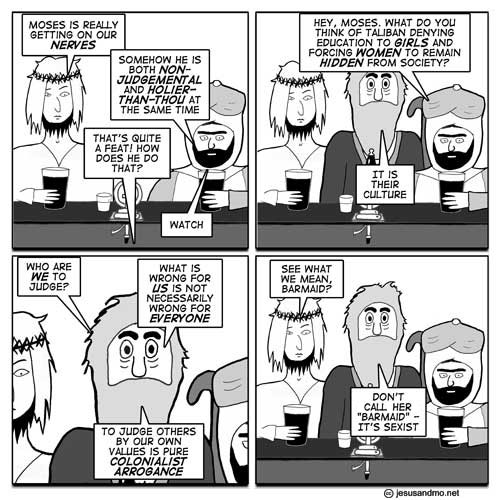Moral relativism is a philosophical concept that posits that moral judgments and ethical standards are not universally applicable but are instead shaped by cultural, social, and personal contexts. This principle invites myriad interpretations and has sparked numerous debates across various fields, including philosophy, sociology, and even art. One of the most impactful mediums of conveying complex philosophical ideas is through cartoons and graphic illustrations. They offer a visual and often humorous perspective that can simplify intricate theories, making them more accessible to a wider audience.
When exploring the world of moral relativism through a cartoon lens, readers can expect a diverse array of content. Cartoons often utilize satire, humor, and caricature to dissect moral dilemmas and ethical quandaries. They serve as a means to challenge prevailing norms and provoke critical thought. By employing exaggerated characters or absurd situations, such cartoons dramatize the inconsistencies inherent in moral relativist arguments. For instance, a cartoon might juxtapose characters from various cultures debating a specific moral issue, showcasing the stark differences in their frameworks and the resulting confusion. This element of humor not only entertains but also invites viewers to contemplate the validity of their belief systems.
Among the types of content that may arise in this realm, one can find socially relevant commentary crafted through clever illustration. These cartoons may focus on contemporary issues such as immigration, human rights, or environmentalism, each exemplifying how differing cultures interpret moral responsibilities. For example, a cartoon depicting polar bears discussing climate change could illustrate the different perspectives different countries hold regarding their role in global warming. Each character could represent varying cultural attitudes towards sustainability, from extreme negligence to vigilant advocacy, thereby elucidating the conflict between individual and collective responsibility.
Moreover, moral relativism cartoons often delve into historical narratives, scrutinizing how past events inform present moral frameworks. Readers might encounter illustrations that depict historical figures confronting moral choices, thereby encouraging reflection on the ways in which society’s ethical standards have evolved. Such content can underscore how societal values shift over time, shaped by cultural evolution and the social zeitgeist. A cartoon showcasing a dialogue between figures like Socrates and a contemporary thinker, debating the principles of justice, can offer profound insight while remaining engaging and relatable.
Another intriguing aspect of this content is its ability to transcend language barriers. Visual satire communicates effectively across cultural divides, enabling audiences worldwide to engage with moral dilemmas without needing extensive linguistic proficiency. This universality is one of the strengths of cartoon representation. Cartoonists utilize symbolism and visual metaphors that resonate on a fundamental human level, allowing for a myriad of interpretations based on the viewer’s own ethical background. Characters drawn in simplistic styles can often express complex emotions and ideas, making the message direct yet impactful.
Furthermore, the interactive elements of some cartoons can enhance content engagement. Cartoon formats are increasingly used in digital media, evolving into webcomics or animated formats that invite user participation. These interactive formats encourage readers to consider their own moral beliefs and those of others, fostering discussions in online forums or social media platforms. Here, audiences can share interpretations, critique illustrations, or even create their own content in response, thereby propelling a collective exploration of moral relativism.
As we delve into the nuances of various genres within the moral relativism cartoon landscape, one should also consider how the medium of delivery influences the message. The choice between single-panel cartoons and multi-panel narratives can significantly affect reader engagement and understanding. Single-panel cartoons often deliver a sharp, poignant observation, packing an entire moral conundrum into a single image that elicits immediate reflection. In contrast, multi-panel comics can facilitate complex storylines, allowing for a deeper exploration of characters and their moral dilemmas. This layered approach can guide audiences through a more comprehensive understanding of ethical philosophies, illustrating the ties between personal experience and universal themes.
Additionally, moral relativism cartoons can serve an educational purpose in formal settings, such as classrooms or workshops. Educators may use these illustrations to spark discussions among students regarding their beliefs and cultural ethics. By analyzing cartoons that portray moral relativism, students can engage in critical thinking about their own moral frameworks, enhancing their understanding of different perspectives and encouraging empathy towards others with differing viewpoints. This pedagogical approach not only promotes intellectual growth but also nurtures social awareness and cultural sensitivity.
In conclusion, moral relativism cartoons encapsulate a breadth of content that encourages intellectual exploration and critical discourse. By leveraging humor and visual storytelling, these cartoons illuminate moral quandaries, fostering a rich dialogue around ethics that resonates across cultural boundaries. As readers navigate this genre, they can expect a vibrant tableau of ideas that challenge their perceptions, promote empathy, and underscore the complexity of moral reasoning in a diverse world. Ultimately, the engagement with such material promotes not only personal reflection but also a collective understanding of the moral tapestry that binds humanity, making it an invaluable aspect of contemporary discourse.
